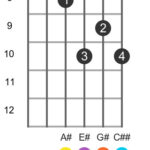Every accomplished guitar player understands the importance of dedicated practice, often referred to as “woodshedding.” This focused time honing your skills is crucial for mastering the instrument. The term “woodshedding” itself evokes images of musicians retreating to a secluded space, like a literal woodshed, to practice without interruption. While your woodshed might be your bedroom or practice room, the need for quality practice material remains the same. Whether you’re tackling a demanding piece like “Cliffs of Dover” or building the foundational technique to even approach such a challenge, having the right resources is essential for effective woodshedding.
For guitarists seeking serious practice material, the Guitar Grimoire series stands out as a formidable collection. These books, encompassing chords, scales, modes, improvisation, and fingerpicking, are designed for in-depth exploration. They present a comprehensive overview of guitar possibilities, making them invaluable tools for dedicated players. However, their substantial size, often an inch thick, can be intimidating to some.
My own journey with the series began with the Guitar Grimoire Scales and Modes. This book is a treasure trove of scales, offering an extensive reference for almost any scale imaginable. While incredibly useful as a reference, the sheer volume of information can feel overwhelming. The question naturally arises: how do you effectively learn and internalize all of this material? This is where the Guitar Grimoire Exercise Book steps in to bridge the gap between knowledge and practical application.
Initially, the Exercise Book might seem like just another collection of repetitive drills. However, a closer look reveals a carefully constructed system of exercises designed to maximize your woodshedding sessions. It’s more than just mindless repetition; it’s a structured approach to developing technique and fretboard fluency.
The Guitar Grimoire Exercise Book is intelligently organized into four key sections:
1. Mastering Major Scales
The exercises in this section are presented in the key of F Major. Crucially, the book provides fundamental diagrams for all major keys. Given the movable nature of guitar patterns, adapting these exercises to different keys becomes straightforward. The initial exercises focus on practicing the F Major Scale using three-notes-per-string (3NPS) patterns. Here, the emphasis is on picking technique. Author Kadmon advocates for economy picking – a technique where string changes are executed on a downstroke when moving from lower to higher strings, and on an upstroke when moving from higher to lower strings. For players already familiar with economy picking, this approach will feel immediately intuitive and efficient.
A standout feature of this section is the inclusion of “coil exercises.” These scalar patterns, arranged in coils of three and four notes, each have specific up and down picking patterns. The effectiveness of these exercises for technique development cannot be overstated. Prepare for your hands to feel the burn – a sign of productive practice! Consistent practice of coil exercises translates to effortlessly executing fast scale runs with enhanced precision and fluidity, almost becoming second nature.
2. Pentatonic Power
The second section dives into pentatonic scales, specifically the minor pentatonic. This section marks a shift to alternate picking, a logical choice given the consistent two-notes-per-string arrangement in pentatonic scales. Interestingly, the picking directions suggested by Kadmon align perfectly with those identified by Troy Grady in his analysis of Eric Johnson’s renowned picking technique. These pentatonic exercises are exceptionally effective for boosting speed and refining overall technique. Even with relatively short practice sessions, noticeable improvements in pentatonic runs that previously felt challenging become apparent.
3. Chord Run Exercises: Beyond Arpeggios
Section three introduces “Chord Run Exercises.” These exercises involve four-note chord shapes played across the fretboard. While not strictly arpeggios in the traditional sense, they provide a unique and challenging workout for your hands, pushing them in unexpected ways. These exercises echo the type of drills often used in classical guitar training, offering a more in-depth and systematic approach to similar concepts.
4. Chromatic Explorations
The final section delves into “Chromatic Exercises.” As Kadmon clarifies, these are not full chromatic scale exercises. Instead, they present over 100 diverse chromatic-style exercises utilizing blocks of four notes per string across the fretboard. While some exercises might be familiar, many offer novel and unconventional challenges, pushing your hands to adapt and develop strength and dexterity in new and surprising ways.
Bonus: The Grimoire Combo for Ultimate Woodshedding
For those seeking an inexhaustible supply of practice material, combining the Exercise Book with the 3NPS and pentatonic scale patterns from the Scales and Modes Guitar Grimoire creates a truly comprehensive practice system. This combination provides a lifetime’s worth of woodshedding content, promising significant and lasting improvements in your guitar technique.
Final Verdict: Is the Guitar Grimoire Exercise Book Worth It?
For guitarists serious about woodshedding and technique enhancement, the Guitar Grimoire Exercise Book is an invaluable resource. Personal experience has shown noticeable improvements in overall technique after consistent, even if not excessively long, daily practice sessions with these exercises. The book not only refines technique but also reinforces knowledge of major scale and pentatonic patterns, particularly beneficial for those already familiar with these fundamental elements.
In conclusion, if your goal is to elevate your guitar technique, the Guitar Grimoire Exercise Book is undoubtedly a must-have addition to your practice toolkit. It’s a powerful resource for unlocking your full potential on the guitar.

